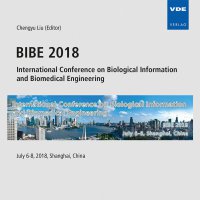Simulation study of biatrial conduction via different conduction path-ways in atrial fibrillation
Konferenz: BIBE 2018 - International Conference on Biological Information and Biomedical Engineering
06.06.2018 - 08.06.2018 in Shanghai, China
Tagungsband: BIBE 2018
Seiten: 3Sprache: EnglischTyp: PDF
Persönliche VDE-Mitglieder erhalten auf diesen Artikel 10% Rabatt
Autoren:
Ouyang, Zhao-lian (Key laboratory for biomechanics and Mechanobiology of Ministry of Education, School of Biological Science and Medical Engineering, Beihang University, Beijing 100083, China & Institute of Medical Information (IMI), Chinese Academy of Medical Sciences (CAMS), Beijing 100020, China & Beijing Advanced Innovation Centre for Biomedical Engineering, Beihang University, Beijing 102402, China)
Sun, Liping (Department of Cardiology, Beijing Shijitan Hospital, Capital Medical University, Beijing 100038, China)
Chi, Hui; Zhang, Ting; Chen, Juan; Shu, Yan (Institute of Medical Information (IMI), Chinese Academy of Medical Sciences (CAMS), Beijing 100020, China)
Xia, Ling; Gong, Yinglan (Department of Biomedical Engineering, Zhejiang University, Hangzhou 310027, China)
Fan, Yubo (Key laboratory for biomechanics and Mechanobiology of Ministry of Education, School of Biological Science and Medical Engineering, Beihang University, Beijing 100083, China & Beijing Advanced Innovation Centre for Biomedical Engineering, Beihang University, Beijing 102402, China & National Research Center for Rehabilitation Technical Aids, Beijing 100176, China)
Inhalt:
Atrial fibrillation (AF) is the most common sustained arrhythmia in clinical practice. Previous simulation show that in normal sinus rhythm, different conduction pathways have great impact on the biatrial conduction patterns, and experiments also show that different conduction pathways may be involved in the biatrial conduction during AF. In this study, MRI images from one patient were used to reconstruct a human atrial anatomical model. Four different conduction pathways were used to represent the biatrial conduction, which were biatrial conduction via only LFO; biatrial conduction via only CS; biatrial conduction via both LFO and CS; both LFO and CS can not conduct electricity. 2 re-entries were induced in the four different cases, and the re-entries were very similar in location and morphology, although one site in two cases had unsustained re-entry. Finally our simulation shows that the conduction pathways may have minor impact on the AF initiation and maintenance.


